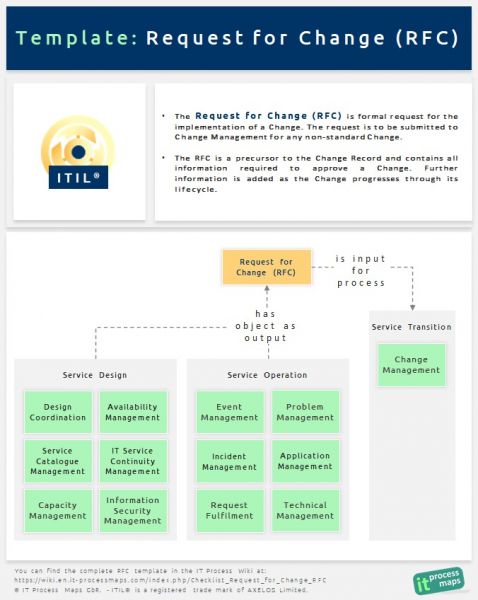Checklist Request for Change RFC

Definition: The Request for Change (RFC) is formal request for the implementation of a Change. The RFC is a precursor to the 'Change Record' and contains all information required to approve a Change. Further information is added as the Change progresses through its lifecycle. The level of detail depends on the size and likely impact of the Change. Often there will be references to further documents containing more detailed information, e.g. a detailed 'Change Proposal'. As major Changes are typically implemented as projects, the RFC often takes on the role of what is also known as a "Project Charter".
ITIL Process: ITIL Service Transition - Change Management
ITIL 4 Practice: Change enablement
Checklist Category: ITIL Templates
A Request for Change is to be submitted to Change Management for any non-standard Change (a set of standard/ routine Changes is usually defined by Change Management; these are minor Changes which do not require submission to the Change Management process).
A Change is backed by a Change Owner, holding a budget for its implementation. In many cases the Change Owner is identical with the RFC initiator. Typically Changes are owned by Service Management roles (e.g. the Problem Manager or Capacity Manager) or by IT management.
Request for Change (RFC) - Contents

A Request for Change contains the following information:
Unique ID
Date of submission
Change Owner
Initiator of the RFC
(if not identical with Change Owner)
Proposed Change priority
(e.g. "Very High (Emergency Change)", "High", "Normal", "Low" - may be overruled by Change Management during Change assessment)
Reference to Change Proposal
(if the Change is related to a Change Proposal submitted at an earlier stage)
Description of the Change being applied for
- Summary description
- Business case
- Reason for the Change to be implemented
- Costs
- Benefits
- Consequences if the Change is not implemented
- References (e.g. to a Problem Record triggering this RFC)
- Business areas on the client-side affected by the Change
- Services affected by the Change
- IT infrastructure components (CIs) affected by the Change
- Technology aspects (is a new technology being introduced?)
Risks during the implementation of the Change
- Identified risks
- Counter-measures (e.g. reversion procedure)
- Back-out strategy for the case of a failed Change implementation
Time schedule
(Predicted/suggested time schedule for the implementation)
Estimate of resources for the implementation
- Required personnel resources (from which areas?)
- Estimated work effort for the required personnel resources
- Cost estimate (itemized for bigger Changes)
Budget
(Statement as to whether a budget is allocated and cleared for this Change)
Additional supporting documents
(If applicable, index of additional supporting documents, e.g. the Service Design Package for major additions or modifications to services)
Approval or rejection
- Date
- Person/ body in charge of the approval (Change Manager/ CAB/ ECAB)
- Change reviewers
- Priority assigned by Change Management
- Restrictions
- If applicable, reasons for rejecting the RFC
Notes
Is based on: 'Checklist Request for Change RFC' from the ITIL Process Map
By: Stefan Kempter ![]() , IT Process Maps.
, IT Process Maps.
Proposed Change priority › Description of the Change › Risks › Approval or rejection






